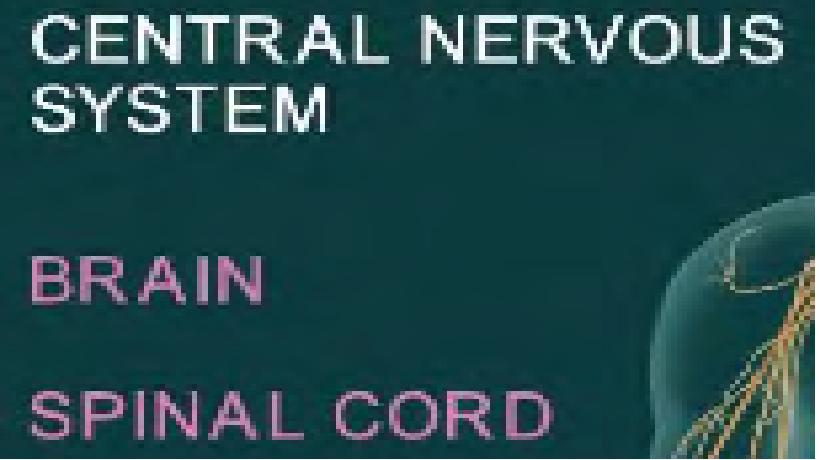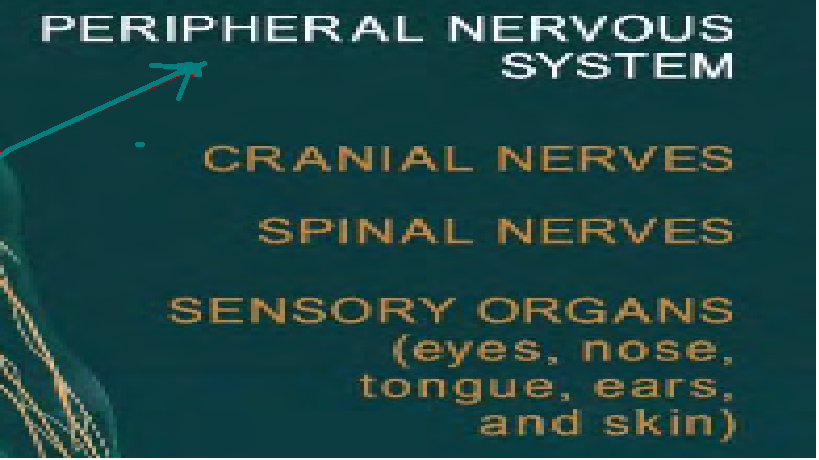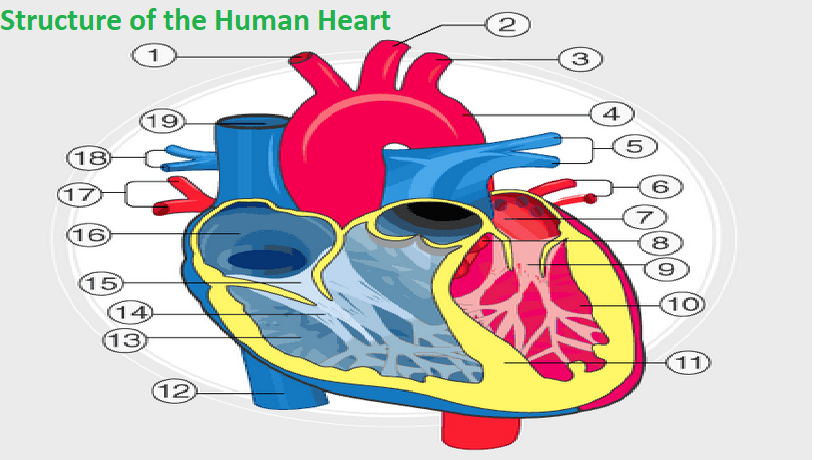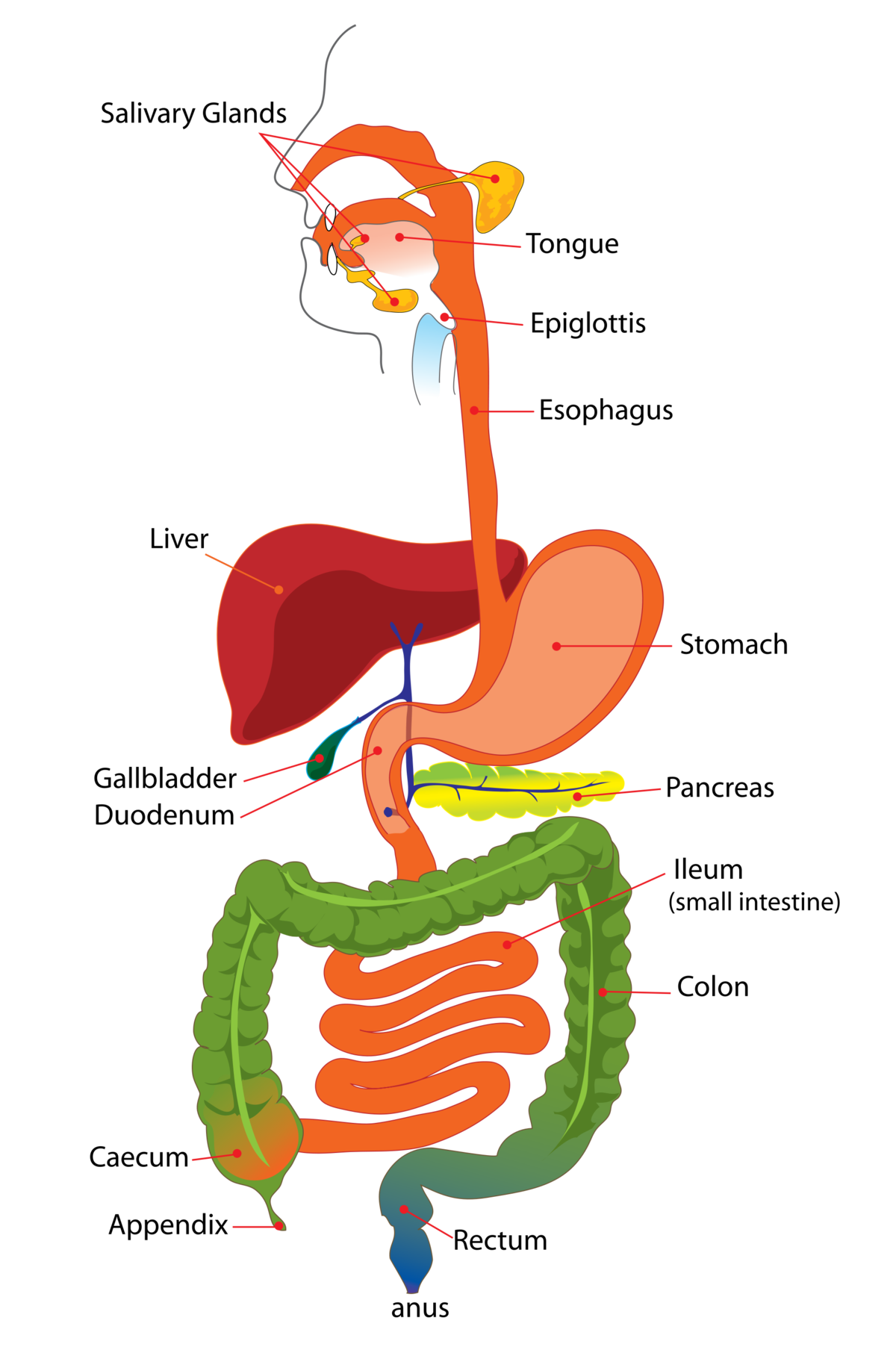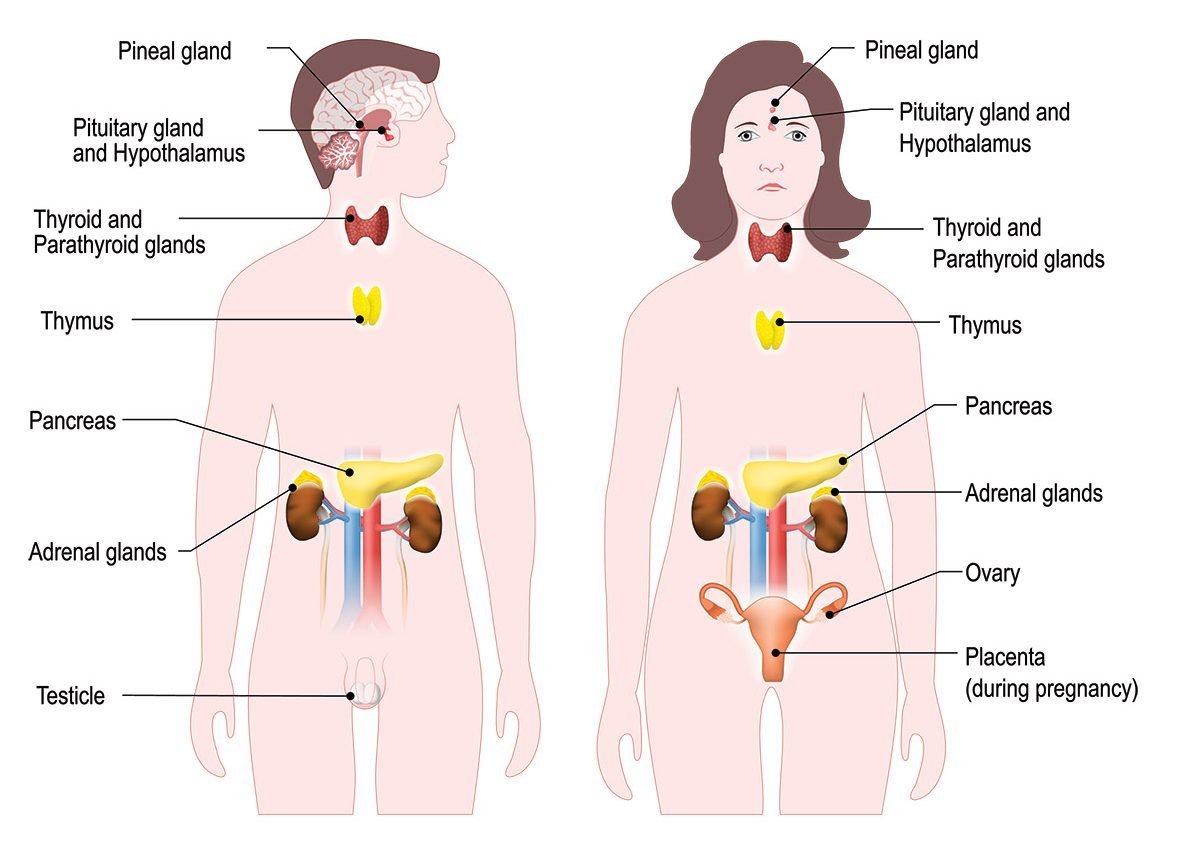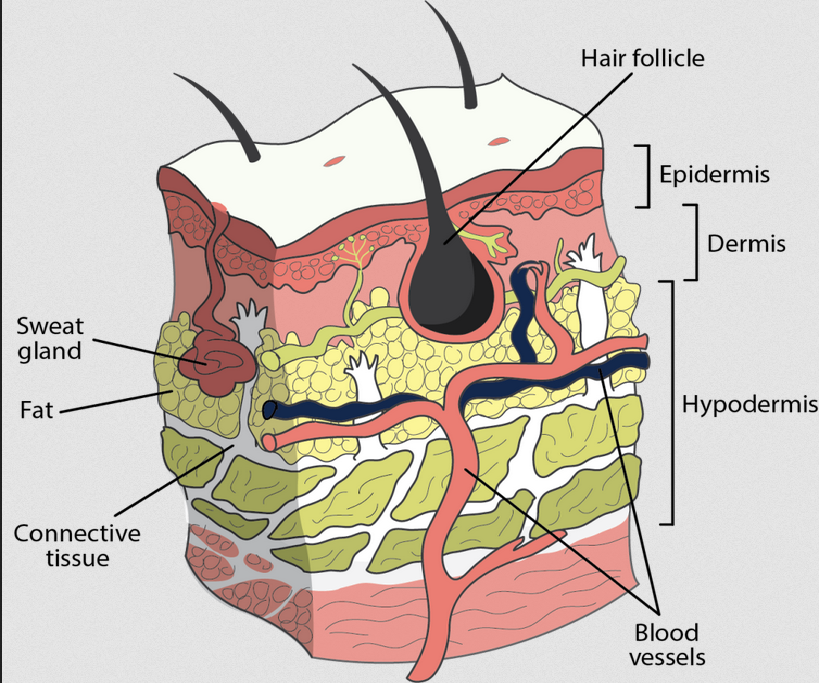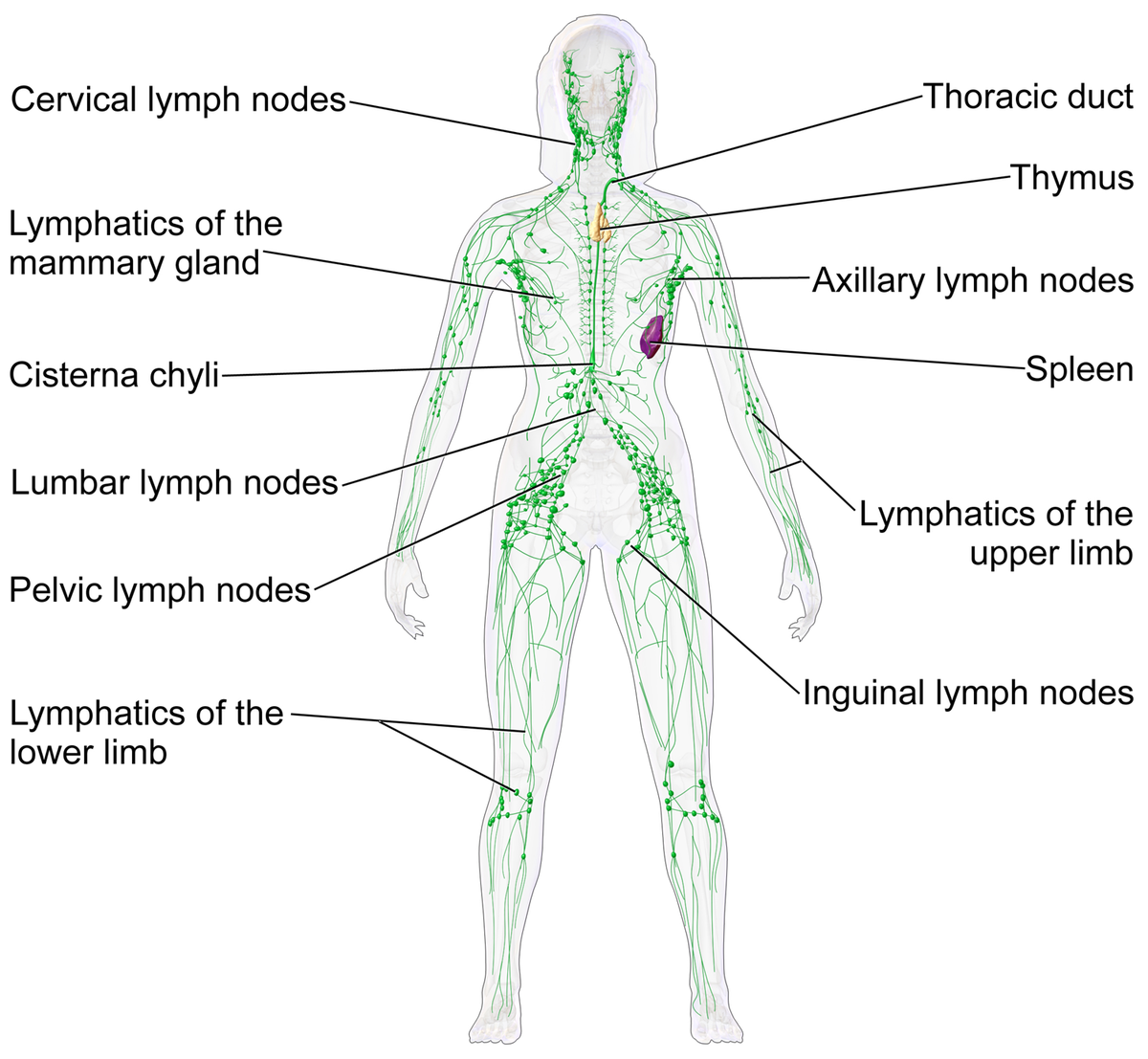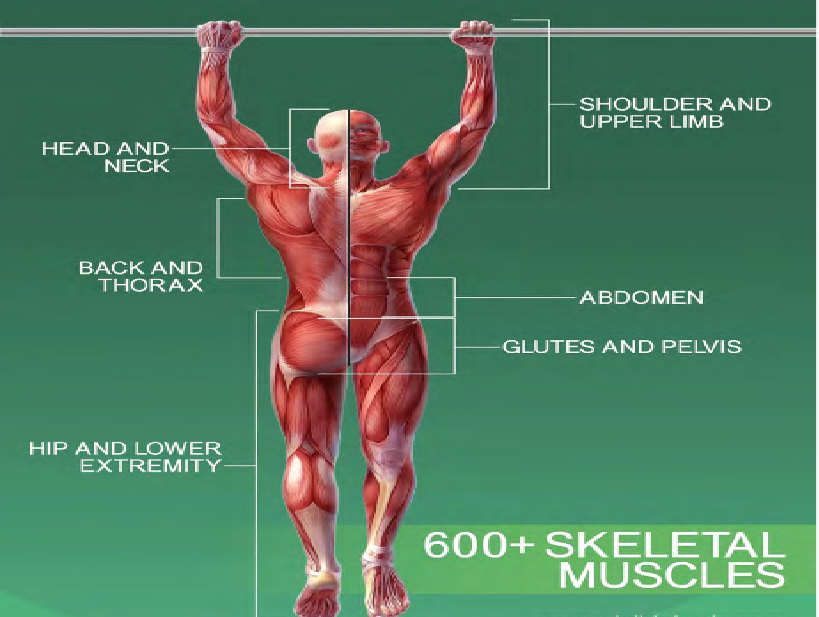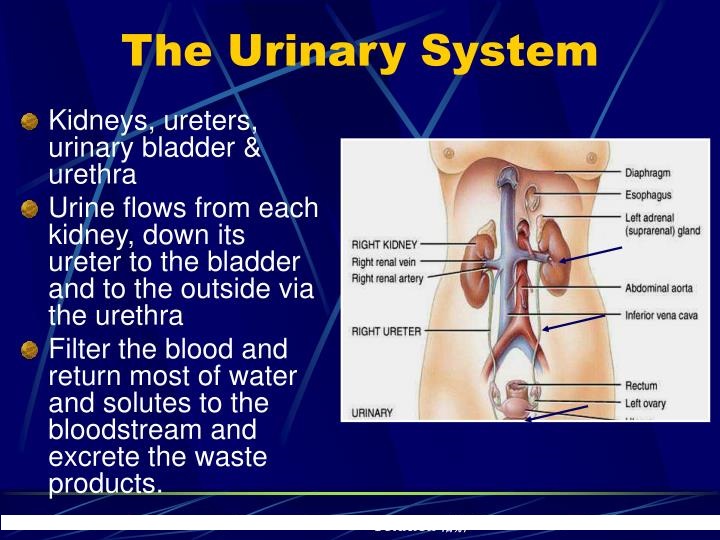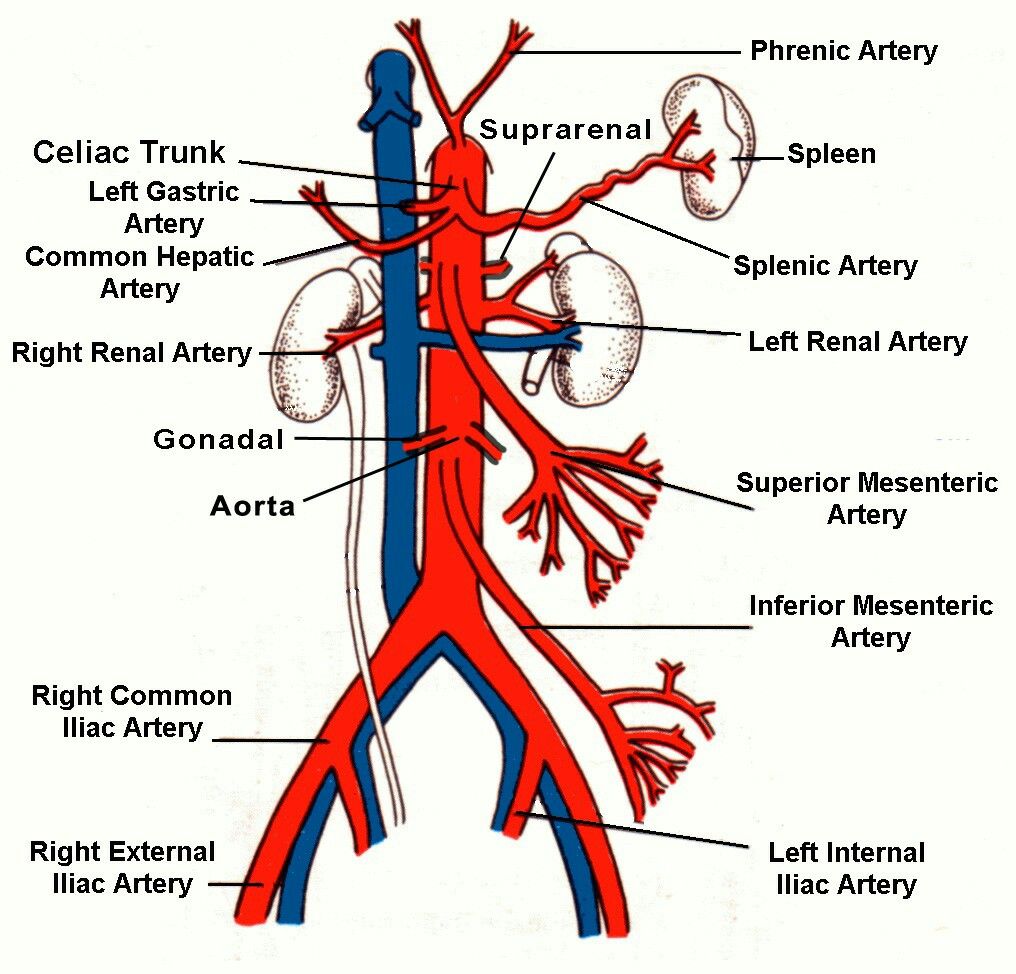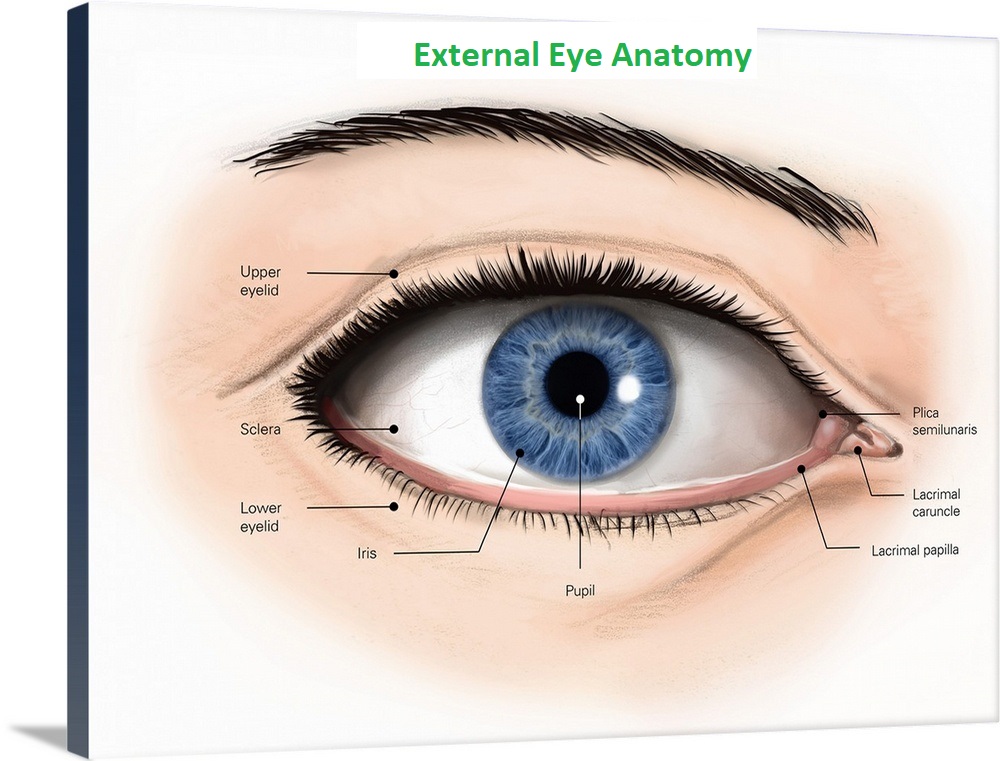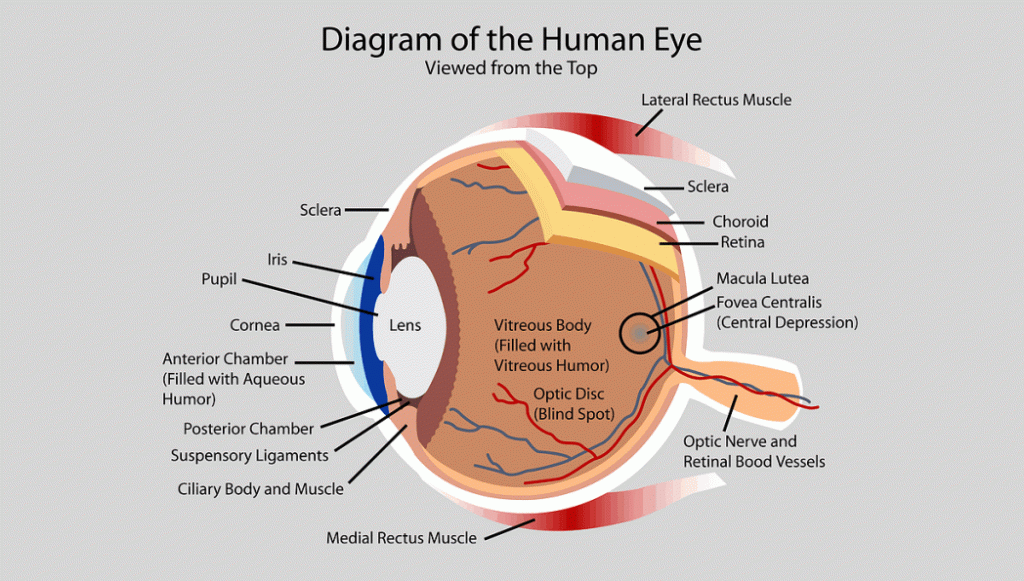How many endocrine system organs are there in the human body?
9
Can you name the endocrine system organs in the human body?
-
Adrenal glands: Two glands that sit on top of the kidneys that release the hormone cortisol.
-
Hypothalamus: A part of the lower middle brain that tells the pituitary gland when to release hormones.
-
Islet cells in the pancreas: Cells in the pancreas control the release of the hormones insulin and glucagon.
-
Parathyroid: Four tiny glands in the neck that play a role in bone development.
-
Pineal gland: A gland found near the center of the brain that may be linked to sleep patterns.
-
Pituitary gland: A gland found at the base of brain behind the sinuses. It is often called the "master gland" because it influences many other glands, especially the thyroid. Problems with the pituitary gland can affect bone growth, a woman's menstrual cycles, and the release of breast milk.
-
Thymus: A gland in the upper chest that helps develop the body's immune system early in life.
-
Thyroid: A butterfly-shaped gland in the front of the neck that controls metabolism.
-
Male
Testes: The male reproductive glands that produce sperm and sex hormones.
Female
Ovaries: The female reproductive organs that release eggs and produce sex hormones.

Pituitary Gland Function
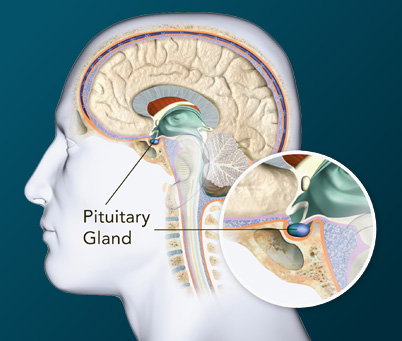
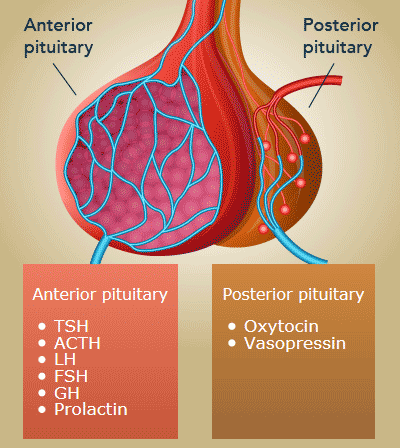
What is the Pituitary Gland?
The pituitary is an endocrine (hormone-producing) gland that sits just beneath the base of the brain, behind the bridge of the nose. It is very small – only about the size of a pea. The pituitary gland is very important as it takes messages from the brain (via a gland called the hypothalamus) and uses these messages to produce hormones that affect many parts of the body, including stimulating all the other hormone-producing glands to produce their own hormones. For this reason it is often referred to as the ‘master gland’.
The pituitary gland has two parts. The anterior (or front) pituitary produces hormones that affect the breasts, adrenals, thyroid, ovaries and testes, as well as several other hormones. The main glands affected by the posterior (or rear) pituitary are the kidneys.
How Does the Normal Pituitary Work?
The pituitary gland produces a number of hormones. Hormones are essential for many aspects of life. Some send messages to other endocrine glands to tell them to increase or decrease production of their hormones. One such example is TSH, which stimulates the thyroid to grow and produce thyroid hormones.
The main hormones produced by the pituitary are:
ACTH adrenocorticotropic hormone
ADH anti-diuretic hormone, or vasopressin
FSH follicle-stimulating hormone
GH growth hormone
LH luteinizing hormone
PRL prolactin
TSH thyroid-stimulating hormone
The endocrine system is a network of glands that produce and release hormones that help control many important body functions, especially the body's ability to change calories into energy that powers cells and organs. The endocrine system influences how your heart beats, how your bones and tissues grow, even your ability to make a baby. It plays a vital role in whether or not you develop diabetes, thyroid disease, growth disorders, sexual dysfunction, and a host of other hormone-related disorders.
Glands of the Endocrine System
Each gland of the endocrine system releases specific hormones into your bloodstream. These hormones travel through your blood to other cells and help control or coordinate many body processes.
Endocrine glands include:
•Adrenal glands: Two glands that sit on top of the kidneys that release the hormone cortisol.
•Hypothalamus: A part of the lower middle brain that tells the pituitary gland when to release hormones.
•Ovaries: The female reproductive organs that release eggs and produce sex hormones.
•Islet cells in the pancreas: Cells in the pancreas control the release of the hormones insulin and glucagon.
•Parathyroid: Four tiny glands in the neck that play a role in bone development.
•Pineal gland: A gland found near the center of the brain that may be linked to sleep patterns.
•Pituitary gland: A gland found at the base of brain behind the sinuses. It is often called the "master gland" because it influences many other glands, especially the thyroid. Problems with the pituitary gland can affect bone growth, a woman's menstrual cycles, and the release of breast milk.
•Testes: The male reproductive glands that produce sperm and sex hormones.
•Thymus: A gland in the upper chest that helps develop the body's immune system early in life.
•Thyroid: A butterfly-shaped gland in the front of the neck that controls metabolism.
Even the slightest hiccup with the function of one or more of these glands can throw off the delicate balance of hormones in your body and lead to an endocrine disorder, or endocrine disease.
The female ovaries and the male testes are a part of which body system? Can these organs be members of more than one organ system? Why or why not?
Testes are one of the main components in the male reproductive system as they are involved in the production of both androgens and sperm. These male gonads are located in the scrotum.
The female gonads are known as ovaries located in the pelvic cavity. These paired ovals are about two to three centimeter each in length. They are the site where production and released of egg cells takes place. Oocyte grows within this environment.
Female ovaries and male testes are the structural components of the reproductive system. These two organs are also part of the endocrine system.
Causes of Endocrine Disorders
Endocrine disorders are typically grouped into two categories:
•Endocrine disease that results when a gland produces too much or too little of an endocrine hormone, called a hormone imbalance.
•Endocrine disease due to the development of lesions (such as nodules or tumors) in the endocrine system, which may or may not affect hormone levels.
The endocrine's feedback system helps control the balance of hormones in the bloodstream. If your body has too much or too little of a certain hormone, the feedback system signals the proper gland or glands to correct the problem. A hormone imbalance may occur if this feedback system has trouble keeping the right level of hormones in the bloodstream, or if your body doesn't clear them out of the bloodstream properly.
Increased or decreased levels of endocrine hormone may be caused by:
•A problem with the endocrine feedback system
•Disease
•Failure of a gland to stimulate another gland to release hormones (for example, a problem with the hypothalamus can disrupt hormone production in the pituitary gland)
•A genetic disorder, such as multiple endocrine meoplasia (MEN) or congenital hypothyroidism
•Infection
•Injury to an endocrine gland
•Tumor of an endocrine gland
Most endocrine tumors and nodules (lumps) are noncancerous. They usually do not spread to other parts of the body. However, a tumor or nodule on the gland may interfere with the gland's hormone production.
Types of Endocrine Disorders
There are many different types of endocrine disorders. Diabetes is the most common endocrine disorder diagnosed in the ______.
Other endocrine disorders include:
Adrenal insufficiency. The adrenal gland releases too little of the hormone cortisol and sometimes, aldosterone. Symptoms include fatigue, stomach upset, dehydration, and skin changes. Addison's disease is a type of adrenal insufficiency.
Cushing's disease. Overproduction of a pituitary gland hormone leads to an overactive adrenal gland. A similar condition called Cushing's syndrome may occur in people, particularly children, who take high doses of corticosteroid medications.
Gigantism (acromegaly) and other growth hormone problems. If the pituitary gland produces too much growth hormone, a child's bones and body parts may grow abnormally fast. If growth hormone levels are too low, a child can stop growing in height.
Hyperthyroidism. The thyroid gland produces too much thyroid hormone, leading to weight loss, fast heart rate, sweating, and nervousness. The most common cause for an overactive thyroid is an autoimmune disorder called Grave's disease.
Hypothyroidism. The thyroid gland does not produce enough thyroid hormone, leading to fatigue, constipation, dry skin, and depression. The underactive gland can cause slowed development in children. Some types of hypothyroidism are present at birth.
Hypopituitarism. The pituitary gland releases little or no hormones. It may be caused by a number of different diseases. Women with this condition may stop getting their periods.
Multiple endocrine neoplasia I and II (MEN I and MEN II). These rare, genetic conditions are passed down through families. They cause tumors of the parathyroid, adrenal, and thyroid glands, leading to overproduction of hormones.
Polycystic ovary syndrome (PCOS). Overproduction of androgens interfere with the development of eggs and their release from the female ovaries. PCOS is a leading cause of infertility.
Precocious puberty. Abnormally early puberty that occurs when glands tell the body to release sex hormones too soon in life.
Testing for Endocrine Disorders
If you have an endocrine disorder, your doctor may refer you to a specialist called an endocrinologist. An endocrinologist is specially trained in problems with the endocrine system.
The symptoms of an endocrine disorder vary widely and depend on the specific gland involved. However, most people with endocrine disease complain of fatigue and weakness.
Blood and urine tests to check your hormone levels can help your doctors determine if you have an endocrine disorder. Imaging tests may be done to help locate or pinpoint a nodule or tumor.
Treatment of endocrine disorders can be complicated, as a change in one hormone level can throw off another. Your doctor or specialist may order routine blood work to check for problems or to determine if your medication or treatment plan needs to be adjusted.
|
Physiology of the Endocrine System
Integumentary system
Lymphatic system
Muscular system
Alphabetical list of Human Muscles
Reproductive system
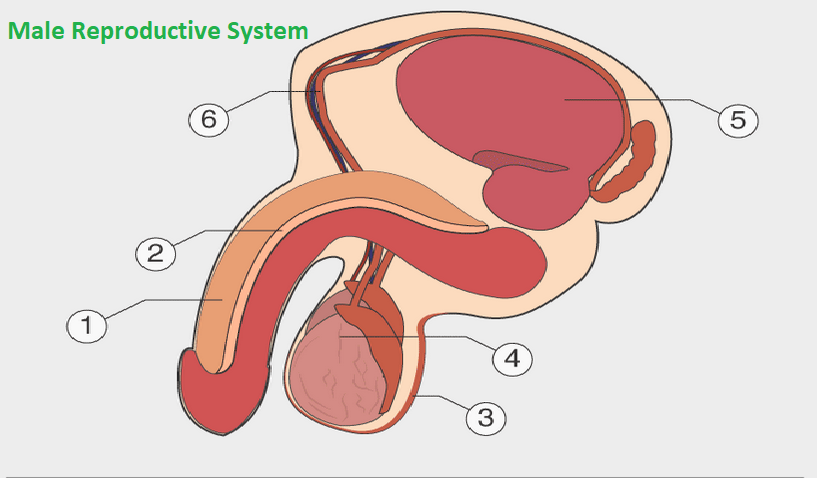
Male Reproductive System
1. Penis
2. Urethra
3. Scrotum
4. Testicle
5. Seminal vesicle
6. Vas deferens
Female Reproductive System
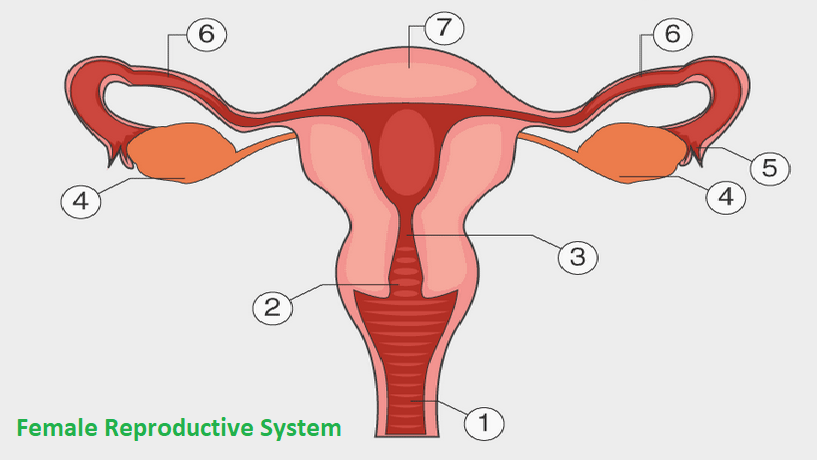
1. Vagina
2. Cervix
3. Endometrium
4. Ovary
5. Fimbriae
6. Fallopian tubes
7. Uterus
|
Respiratory system

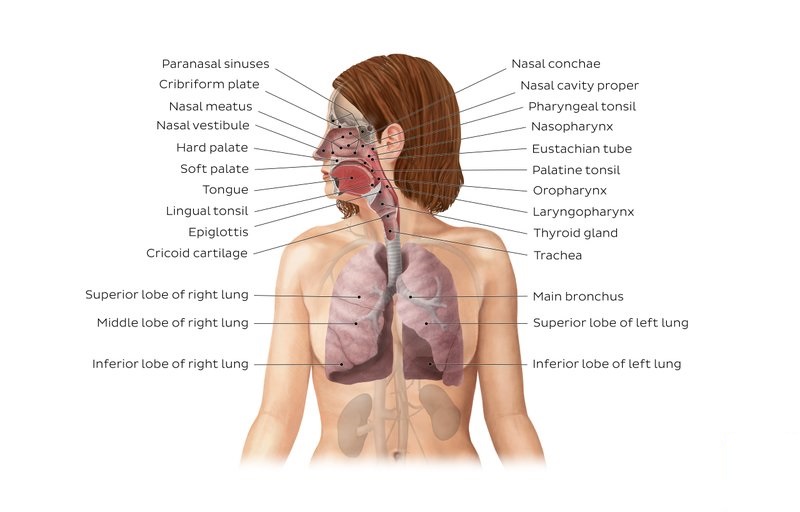
Respiratory System Parts and Functions
Nose / Nasal cavity
Pharynx
Larynx
Trachea
Bronchi
Lungs
Alveoli
Heart
|
Skeletal system
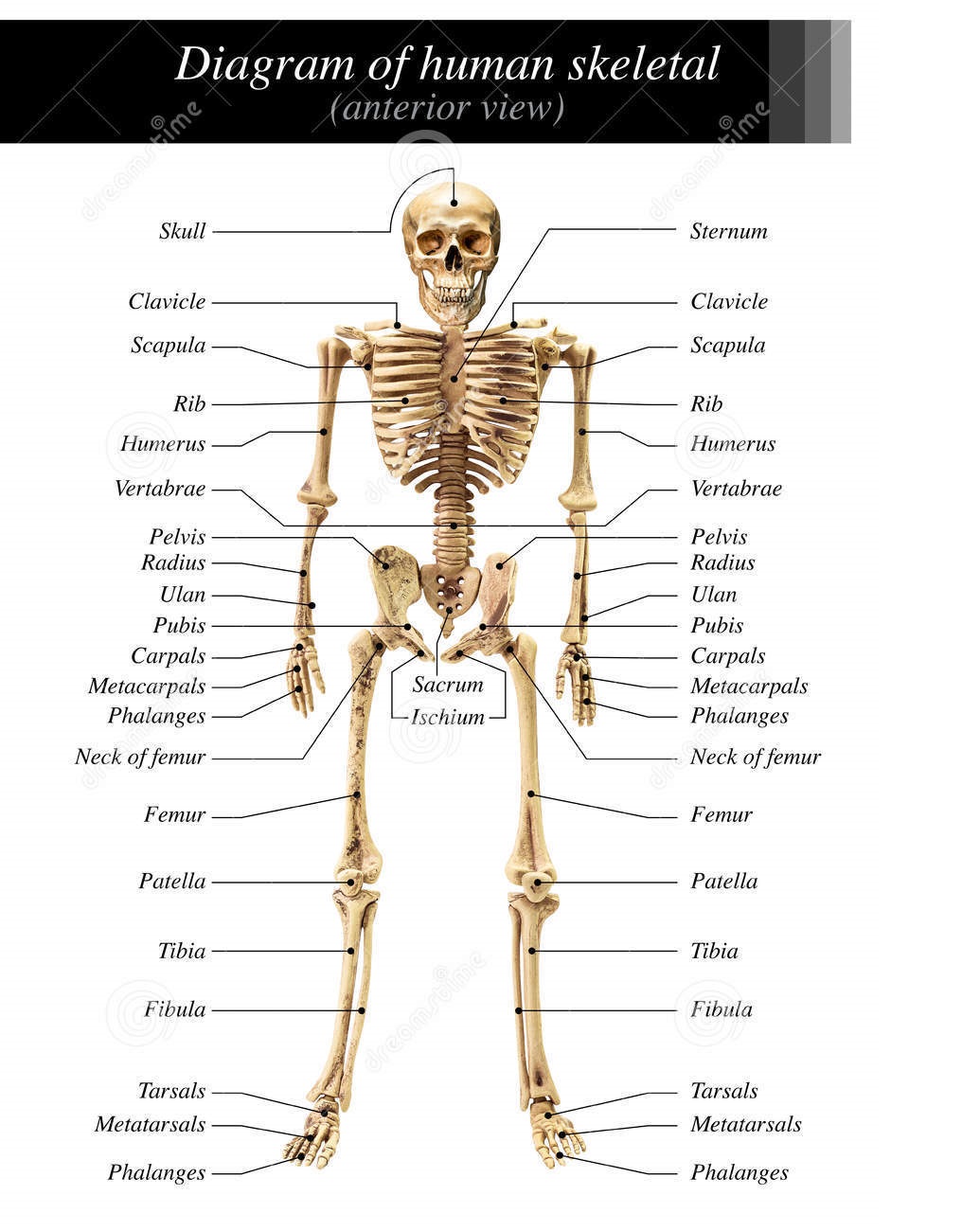
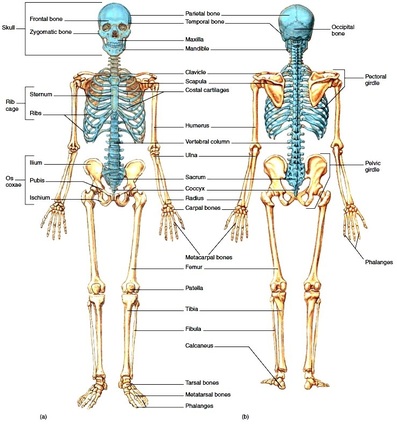
|
Human Skeleton Questions and Answers
The skeletal system is made of _______.
The skeletal system is made of bones and cartilage.
Appendicular Skeleton all the bones of the extremeties and their attachment points.
Axial Skeleton all bones along the midline.
epiphesies the ends of the bones.
How are the ribs numbered? 1–12; starting at the very top.
How many bones are the skull? 22 bones.
How many bones make up each arm? 30
How many bones make up each leg? 30
How many bones make up the pectoral girdal? 2
How many bones make up the pelvic girdal? 3
How many carpals are there per wrist? 8
How many cranial bones are there in the skull? 8
How many facial bones are there in the skull? 14
How many falanges are there? 14
How many falanges make up the toes? 14
How many groupings of vertebrae are there in your spine? 5
How many metacarpals are there? 5
How many metatarsels are there? 5
How many named bones are there in the body? 206
How many ribs are there? 24; 12 sets
How many tarsels are there per ankle? 7
How many types of bone tissue are there? two.
How many types of bones are there? four
How many types of cells of bone tissue are there? four.
How many vertebrae are in the sacrum? 5
How many vertebrae are there in the spine? 33
How many vertebrae make up the cervical? 7
How many vertebrae make up the coccyx? 4
How many vertebrae make up the lumbar? 5
How many vertebrae makes up the theracic? 12
How much of your height does your "torso" make up? 2/5
ossification process by which bones form.
What are ribs 11–12 called? floating ribs
What are ribs 1–7 called? true ribs
What are ribs 8–10 called? false ribs
What are the ankle bones called? tarsels
What are the bones that make up the fingers? falanges
What are the bones that make up the hand? metacarpals
What are the bones that make up the pectoral girdal? –clavical
–scapula
What are the bones that make up the pelvic girdal? –ilium
–ischium
–pubis
What are the bones that make up the wrist? carpals
What are the ends of bones called? epiphesies.
What are the foot bones called? metatarsels
What are the four types of bones? –long bones
–short bones
–flat bones
–irregular bones
What are the four types of cells of bone tissues? –osteoprogenitor
–osteoblasts
–osteoclasts
–osteocytes
What are the functions of the bones? –support (framework)
–protection of the internal organs
–movement (muscle attachments)
–mineral homeostasis (bone tissue stores minerals)
–hemopolesis (blood cell reproduction)
–storage of energy (yellow marrow)
What are the functions of the vertebrae of the spine? –protects spinal cord
–allows bending/movement
–supports skull
What are the groupings of vertebrae in the spine? –cervical
–theracic
–lumbar
–sacrum
–coccyx
What are the parts of the sternum? –manubrium
–body
–xphoid process
What are the purposes of flat bones? –protection
–muscle attachment
What are the purposes of long bones? –weigth distribution (curve in bones)
–strength
–support structure
What are the purposes of the lumbar vertebrae? –most weight supported
–major back muscle attachments
What are the purposes of the skeletal system? –protects organs
–allows us to move
What are the rounded edges of the ilium? iliac crest
What are the types of bone tissue? –compact bone tissue
–spongy bone tissue
What are two other names for the skeletal system? Frame Work; Structure
What bone is between the orbit? ethmoid
What bone makes up the bridge of the nose? nasal
What bone makes up the cheek bones? zygomatics
What bone makes up the chin? mandible
What bone makes up the inner wall of the orbit? lacrimal
What bone makes up the inside walls of the nose? inferior nasal concha
What bone makes up the middle/base of the skull? sphenoid.
What bone makes up the roof of the mouth? palatine
What bone makes up the upper jaw? maxilla.
What bone seperates the nostrils? vomer
What bones are part of the cranium? –frontal
–occipital
–2 parietal
–2 temporal
–sphenoid
–ethmoid
What bones are part of the face? –2 nasal bones
–2 maxilla
–2 zygomatic
–mandible
–2 lacrimal
–2 palatine
–vomer
–2 inferior nasal concha
What do flat bones look like? very thin bones. (cranium, sternum)
What do irregular bones look like? they are odd shaped and do not fit in with any other category. (facial bones, vertebrae)
What do long bones look like? they are greater in length than width. (thigh bone, fingers, humerus)
What do osteoclast cells do? they help develop new bone (growth, maintenance, repair)
What do osteocyte cells do? they help other bone cells mature.
What do short bones look like? almost cube shaped. (carpals, tarsels)
What do the lumbar vertebrae look like? largest and strongest vertebrae.
What do the osteoblasts cells do? they are cells that form the bone. (collagen)
What do the osteoprogenitor cells do? they are the "supervisor" cells.
What is costal cartilage? part of rib that attaches to sternum.
What is special about the mandible? only bone in the whole body that moves.
What is the atlas? the vertebrae that the skull rests upon.
What is the axis? the vertebrae that allows the skull to rotate.
What is the bone that is closest to the pinky finger? ulna
What is the bone that is closest to the thumb? radius
What is the bone that makes up the back of the skull? occipital.
What is the bone that makes up the forehead? frontal.
What is the bone that makes up the hips? ilium
What is the bone that makes up the pubic area? pubis
What is the bone that makes up the top of the skull, seperated by a suture? parietal
What is the bone that makes up the upper arm bone? humerous
What is the bone that makes up your temples? temporal
What is the bottom of the sternum called? xphoid process
What is the calcaneus? the heel bone
What is the coccyx vertebrae? bone attached to sacrum with ligaments.
What is the hyoid bone and where is it located? bone suspended by ligaments that is in front of the windpipe.
What is the iliac crest? the rounded edges of the ilium
What is the ischium? the butt bone
What is the meaning of anterior? nearer to the front of the body
What is the meaning of contralateral? on opposite sides of the body
What is the meaning of deep? further away from the surface of the body
What is the meaning of distal? further away from the attachment of an extremity
What is the meaning of inferior? away from the head or toward the lower part of the structure
What is the meaning of intermediate? between two structures
What is the meaning of ipsilateral? on the same side of the body
What is the meaning of lateral? farther away from the midline of the body
What is the meaning of medial? nearer to the midline of the body
What is the meaning of parietal? pertaining to or forming outer wall of body cavity
What is the meaning of posterior? nearer to the back of the body
What is the meaning of proximal? nearer to the attachment of an extremity.
What is the meaning of superficial? closer to the surface of the body
What is the meaning of superior? toward the head or upper part of the structure
What is the meaning of the word fontanels? "soft spots" on a newborn before the sutures are formed.
What is the meaning of the word orbit? eye socket.
What is the meaning of the word suture? immovable joints found only in the skull.
What is the meaning of visceral? pertaining to the covering of an organ
What is the middle of the sternum called? body
What is the name for all bones along the midline? Axial Skeleton.
What is the name for all the bones of the extremeties and their attachment points? Appendicular Skeleton.
What is the name of the butt bone? ischium
What is the name of the knee cap? patella
What is the name of the thicker bone in the lower leg (the shin)? tibia
What is the name of the thigh bone? femur
What is the name of the thinner bone in the lower leg? fibula
What is the only tarsel bone that joins both tibia and fibula? talus
What is the process by which bone forms? ossification
What is the purpose of the compact bone tissue? protection.
What is the purpose of the hyoid bone? protect windpipe.
What is the purpose of the pectoral girdal? attachment and support of upper extremeties
What is the purpose of the spongy bone tissue? stores bone marrow. (production of blood cells)
What is the purposes of the pelvic girdal? –center of gravity
–distribute weight for lower extremeties
What is the skeletal system made up of? ligaments, bones, cartilage
What is the sternum? the "breast bone"
What is the talus? a tarsel that joins both tibia and fibula
What is the tarsel that makes up the heel bone? calcaneus
What is the top of the sternum called? manubrium
What is the vertebrae that the skull rests upon? atlas
What is the vertebrae that the skull rotates on? axis
What is the word for immovable joints found only in the skull? suture
What is the word for the "soft spots" on a newborn before the sutures are formed? fontanels
What is the word for the meaning "toward the head or upper part of the structure"? superior
What is the word meaning "away from the head or toward the lower part of the structure"? inferior
What is the word meaning "between two structures"? intermediate
What is the word meaning "closer to the surface of the body"? superficial
What is the word meaning "further away from the attachment of an extremity"? distal
What is the word meaning "further away from the midline of the body"? lateral
What is the word meaning "further away from the surface of the body"? deep
What is the word meaning "nearer to the attachment of an extremity"? proximal
What is the word meaning "nearer to the back of the body"? posterior
What is the word meaning "nearer to the front of the body"? anterior
What is the word meaning "nearer to the midline of the body"? medial
What is the word meaning "on opposite sides of the body"? contralateral
What is the word meaning "on the same side of the body"? ipsilateral
What is the word meaning "pertaining to or forming outer wall of body cavity"? parietal
What is the word meaning "pertaining to the covering of an organ"? visceral
What is the word meaning the eye socket? orbit.
What makes up the cervical vertebrae? C1–C7; C1=atlas; C2=axis
What makes up the collar bone? clavical
What makes up the sacrum vertebrae? foundation for pelvic girdal; spinal cords ends.
What makes up the shoulder blades? scapula
What makes up the theracic vertebrae? T1–T12; each attached to set of ribs.
What types of bones are there in the skull? –cranial
–facial
Where are the compact bone tissues located? on the shafts of the long bones.
Where are the inferior nasal concha located? inside nose.
Where are the lacrimal located? inner wall of orbit.
Where are the maxilla located? the upper jaw seperated by suture.
Where are the nasal bones located? they make up the bridge of the nose.
Where are the palatine located? roof of mouth, seperated by suture.
Where are the parietal bones located? they are the top/sides of the skull seperated by a suture.
Where are the sacrum vertebrae located? between hip bones.
Where are the spongy bone tissues located? on the short, irregular, and flat bones. Also on the ends of long bones.
Where are the temporal bones located? At the area of your "temples"
Where are the zygomatics located? cheek bones.
Where is the body? the middle part of the sternum
Where is the calcaneus located? the ankle
Where is the cervical vertebrae? the neck.
Where is the clavical located? collar bone
Where is the ethmoid located? between the orbit.
Where is the femur located? the thigh
Where is the fibula located? the lower leg
Where is the frontal bone located? It makes up the "forehead" part of the skull.
Where is the humerous located? the upper arm
Where is the ilium located? the hips
Where is the lumbar vertebrae? lower back.
Where is the mandible located? chin.
Where is the manubrium? the top part of the sternum
Where is the occipital bone located? It makes up the back of the skull.
Where is the patella located? the knee cap
Where is the pubis located? the pubic hair area
Where is the radius located? lower arm; close to the thumb.
Where is the scapula located? shoulder blades.
Where is the sphenoid located? middle/base of the skull.
Where is the talus located? the ankle
Where is the theracic vertebrae? the chest/ribs.
Where is the tibia located? the lower leg; shin
Where is the ulna located? lower arm; close to the pinky.
Where is the vomer located? seperates nostrils, "septum"
Where is the weakspot of the clavical? the middle.
Where is the xphoid process? the bottom of the sternum
Which bone cells are the "supervisor" cells? Osteoprogenitor Cells
Which bone cells develop new bone? Osteoclast Cells
Which bone cells help form the bone? Osteoblast Cells
Which bone cells help other bone cells mature? Osteocyte Cells
Which bone is the only one suspended by ligaments? Hyoid
Why are ribs 11–12 called floating ribs? because they do not attach to sternum at all. attached to T11 and T12
Why are ribs 1–7 called true ribs? because they are attached directly to the sternum.
Why are ribs 8–10 called false ribs? because they attach indirectly through the costal cartilage of rib 7.
|
Urinary system
Anatomy, physiology, and biochemistry of human beings.
-
General Anatomy and Physiology of a Human
-
Dissection
-
Osteology
-
Upper Limb
-
Head and Neck
-
Thorax
-
Abdomen
-
Pelvis and Perineum
-
Lower Limb
-
Cranial Nerves
-
Spinal Nerves
-
Brain
-
Brachial Plexus
Here are further guidelines.
Here are further guidelines.
Here are further guidelines.
|
Why have the anatomy, physiology, and biochemistry of human beings been put together?
In olden days, a specific physician had to take 18-month courses in anatomy, physiology, and biochemistry of human beings.
Some such anatomy, physiology, and biochemistry of human beings courses were more than required for specific physicians.
Anatomy, physiology, and biochemistry of human beings resources are relevant to specific physicians’ real-world services.
Anatomy, physiology, and biochemistry of human beings resources require curriculum reform as recommended by Doctor Asif Qureshi.
What should specific physicians know about the anatomy, physiology, and biochemistry of human beings?
Here are further guidelines.
http://www.qureshiuniversity.org/biologyworld.html
http://www.qureshiuniversity.org/human.html
What are you expected to know about a matured human?
Annotations or definition.
Abilities.
Bones.
Drugs required for human medical conditions.
Equipment required for human medical conditions.
Health care settings.
Human anatomy by category.
Resources required for human health care.
Internal organs (main).
Muscles.
Medical conditions.
Systems of the human body
Survival needs.
What is a human?
Human as per scientific classification.
Human as per human body systems.
Human as per matured human abilities.
How many human body systems are there?
11
What are the names of human body systems?
http://www.qureshiuniversity.com/human.html
How many bones, muscles, internal organs, and cells does a mature human have?
Bones: 206
Internal organs (main): 22
Muscles: 600
100 trillion cells
How many human body bones are there in one matured human being?
(206)
What are the names of human body bones?
www.qureshiuniversity.com/human.html
How many human body muscles are there in one matured human being?
600 muscles
What are the names of human body muscles?
www.qureshiuniversity.com/human.html
Human anatomy by category
How many human anatomy categories are there?
19
What should you know about human anatomy by category?
www.qureshiuniversity.com/human.html
How many human body internal organs are there in one human being?
22 internal organs
78 organs
What are the names of human body internal organs?
www.qureshiuniversity.com/human.html
How many abilities should a matured human have relevant to age?
24 abilities.
What is a matured human?
A matured human is an individual between 18 to 75 years old.
What are examples of matured human abilities relevant to age?
Abstract reasoning
Breathing
Clothing
Cooking food
Communicating through various means (written, spoken, sign language). English language
Caring for oneself (eating, dressing, toileting, etc.)
Creating and using numerous other technologies
Creating and extinguishing fires or heat
Following a variety of values, social norms, and rituals
Getting started after sleep
Hearing
Intellectual ability knowledge, English language abilities, and able to answer
Learning
Language (English language, problem solving)
Moving or manipulating objects
Performing manual tasks
Replying to relevant questions
Seeing
Speaking
Sitting
Sleeping normally
Having sexual desire
Working
Walking
This is applicable to 18–75-year-olds.
If an individual is less that 18 or more than 75 and feels issues are not due to age less than 18 or old age, that individual needs evaluation as well.
What are recommendations to other medical colleges?
Various medical colleges start with anatomy, physiology, biochemistry, pediatrics, ear nose & throat, forensic medicine, ophthalmology, preventive and social medicine and end with medicine, surgery, obstetrics and gynecology.
They must start directly with a medical condition. Each medical condition should be enumerated in at least 40 questions and answers with relevant anatomy, physiology, biochemistry, microbiology, pathology, pharmacology, and preventive concepts.
What human anatomy should one know relevant to this medical condition?
What human physiology should one know relevant to this medical condition?
What human biochemistry should one know relevant to this medical condition?
What human microbiology should one know relevant to this medical condition?
If one needs these questions and answers, Qureshi University is willing to provide them.
|
Advice for postgraduate physicians.
Here are few suggestions for you.
This is for those who are counseled to appear for any examination for postgraduation.
Examination before postgraduation is futile exercise.
Relevant questions must be answered.
You must get profiled by your guide for abilities with recommendations.
Any postgraduation cannot teach you more than what is elaborated at www.qureshiuniveristy.com/healthcareworld.html
Because of the computer and Internet, a physician can enhance his/her further abilities at home or home office with computer and Internet and connect to www.qureshiuniveristy.com/healthcareworld.html
You need to maintain all these guidelines separately for future review, including guidelines at www.qureshiuniversity.com/healthcareworld.html.
All these useless and unreasonable examinations for further studies or postgraduate studies can be challenged in courts in the state.
Is there any standard examination and justified examination for physicians that can get them a postgraduation training program for further studies?
No.
How should any physician go ahead with any postgraduation in a state?
Questions you need to answer.
What is the profile of your guide?
In what state do you plan to offer professional services of a physician?
Do you plan to be around Asif Qureshi?
If you plan to be around Asif Qureshi, you must visit www.qureshiuniversity.com/healthcareworld.html every day.
You must call every Sunday.
You must call on other days if required.
If required, email or call that you would like to speak with me and I will call or email from this side.
No resource can guide you better than the guidelines at www.qureshiuniversity.com/healthcareworld.html resources.
If others contend that there are better resources, they must display them publicly like those at www.qureshiuniversity.com/healthcareworld.html.
What do I expect from you?
You will maintain all communications and learning materials you get.
You are first a physician, then a specialist and superspecialist.
Here are further guidelines.
|
1. Osteology
| |
1. Introduction | |
2. Bone |
3. The Vertebral Column
a. General Characteristics of a Vertebra
1. The Cervical Vertebrae
2. The Thoracic Vertebrae
3. The Lumbar Vertebrae
4. The Sacral and Coccygeal Vertebrae
b. The Vertebral Column as a Whole |
4. The Thorax
a. The Sternum
b. The Ribs
c. The Costal Cartilages |
5. The Skull
a. The Cranial Bones
1. The Occipital Bone
2. The Parietal Bone
3. The Frontal Bone
4. The Temporal Bone
5. The Sphenoid Bone
6. Ethmoid bone
b. The Facial Bones
1. The Nasal Bones
2. The Maxill� (Upper Jaw)
3. The Lacrimal Bone
4. The Zygomatic Bone
5. The Palatine Bone
6. The Inferior Nasal Concha
7. The Vomer
8. The Mandible (Lower Jaw)
9. The Hyoid Bone
c. The Exterior of the Skull
d. The Interior of the Skull
|
6. The Extremities
a. The Bones of the Upper Extremity
1. The Clavicle
2. The Scapula
3. The Humerus
4. The Ulna
5. The Radius
b. The Hand
1. The Carpus
2. The Metacarpus
3. The Phalanges of the Hand
c. The Bones of the Lower Extremity
1. The Hip Bone
2. The Pelvis
3. The Femur
4. The Patella
5. The Tibia
6. The Fibula
d. The Foot
1. The Tarsus
2. The Metatarsus
3. The Phalanges of the Foot
4. Comparison of the Bones of the Hand and Foot
5. The Sesamoid Bones |
2. Joints | |
1. Introduction | |
2. Development of the Joints | |
3. Classification of Joints | |
4. The Kind of Movement Admitted in Joints |
5. Articulations of the Trunk
a. Articulations of the Vertebral Column
b. Articulation of the Atlas with the Epistropheus or Axis
c. Articulations of the Vertebral Column with the Cranium
d. Articulation of the Mandible
e. Costovertebral Articulations
f. Sternocostal Articulations
g. Articulation of the Manubrium and Body of the Sternum
h. Articulation of the Vertebral Column with the Pelvis
i. Articulations of the Pelvis |
6. Articulations of the Upper Extremity
a. Sternoclavicular Articulation
b. Acromioclavicular Articulation
c. Humeral Articulation or Shoulder-joint
d. Elbow-joint
e. Radioulnar Articulation
f. Radiocarpal Articulation or Wrist-joint
g. Intercarpal Articulations
h. Carpometacarpal Articulations
i. Intermetacarpal Articulations
j. Metacarpophalangeal Articulations
k. Articulations of the Digits |
7. Articulations of the Lower Extremity
a. Coxal Articulation or Hip-joint
b. The Knee-joint
c. Articulations between the Tibia and Fibula
d. Talocrural Articulation or Ankle-joint
e. Intertarsal Articulations
f. Tarsometatarsal Articulations
g. Intermetatarsal Articulations
h. Metatarsophalangeal Articulations
i. Articulations of the Digits
j. Arches of the Foot
| |
| |
1. Mechanics of Muscle | |
2. Development of the Muscles | |
3. Tendons, Aponeuroses, and Fasci� |
4. The Fascae and Muscles of the Head.
a. The Muscles of the Scalp
b. The Muscles of the Eyelid
c. The Muscles of the Nose
d. The Muscles of the Mouth
e. The Muscles of Mastication |
5. The Fascae and Muscles of the Anterolateral Region of the Neck
a. The Superficial Cervical Muscle
b. The Lateral Cervical Muscles
c. The Supra- and Infrahyoid Muscles
d. The Anterior Vertebral Muscles
e. The Lateral Vertebral Muscles |
6. The Fascae and Muscles of the Trunk
a. The Deep Muscles of the Back
b. The Suboccipital Muscles
c. The Muscles of the Thorax
d. The Muscles and Fasci� of the Abdomen
e. The Muscles and Fasci� of the Pelvis
f. The Muscles and Fasci� of the Perineum |
7. The Fascia and Muscles of the Upper Extremity
a. The Muscles Connecting the Upper Extremity to the Vertebral Column
b. The Muscles Connecting the Upper Extremity to the Anterior and Lateral Thoracic Walls
c. The Muscles and Fasci� of the Shoulder
d. The Muscles and Fasci� of the Arm
e. The Muscles and Fasci� of the Forearm
f. The Muscles and Fasci� of the Hand |
8. The Muscles and Fasci� of the Lower Extremity.
a. The Muscles and Fasci� of the Iliac Region
b. The Muscles and Fasci� of the Thigh
c. The Muscles and Fasci� of the Leg
d. The Fasci� Around the Ankle
e. The Muscles and Fasci� of the Foot
|
4. Angiology
| |
1. Introduction | |
2. The Blood | |
3. Development of the Vascular System |
4. The Thoracic Cavity
a. The Pericardium
b. The Heart
c. Peculiarities in the Vascular System in the Fetus
|
5. The Arteries
| |
1. Introduction | |
2. The Aorta |
3. The Arteries of the Head and Neck
a. The Common Carotid Artery
1. Relations
2. The External Carotid Artery
3. The Triangles of the Neck
4. The Internal Carotid Artery
b. The Arteries of the Brain |
4. The Arteries of the Upper Extremity
a. The Subclavian Artery
b. The Axilla
1. The Axillary Artery
2. The Brachial Artery
3. The Radial Artery
4. The Ulnar Artery |
5. The Arteries of the Trunk
a. The Descending Aorta
1. The Thoracic Aorta
2. The Abdominal Aorta
b. The Common Iliac Arteries
1. The Hypogastric Artery
2. The External Iliac Artery |
6. The Arteries of the Lower Extremity
a. The Femoral Artery
b. The Popliteal Fossa
c. The Popliteal Artery
d. The Anterior Tibial Artery
e. The Arteria Dorsalis Pedis
f. The Posterior Tibial Artery
|
6. The Veins | |
1. Introduction | |
2. The Pulmonary Veins |
3. Th. The Veins of the Heart
b. The Veins of the Head and Neck
1. The Veins of the Exterior of the Head and Face
2. The Veins of the Neck
3. The Diploic Veins
4. The Veins of the Brain
5. The Sinuses of the Dura Mater. Ophthalmic Veins and Emissary Veins
c. The Veins of the Upper Extremity and Thorax
d. The Veins of the Lower Extremity, Abdomen, and Pelvis | |
4. The Portal System of Veins
|
7. The Lymphatic System
| |
1. Introduction | |
2. The Thoractic Duct | |
3. The Lymphatics of the Head, Face, and Neck | |
4. The Lymphatics of the Upper Extremity | |
5. The Lymphatics of the Lower Extremity | |
6. The Lymphatics of the Abdomen and Pelvis | |
7. The Lymphatic Vessels of the Thorax
| |
| |
1. Structure of the Nervous System | |
2. Development of the Nervous System | |
3. The Spinal Cord or Medulla Spinalis |
4. The Brain or Encephalon
a. The Hind-brain or Rhombencephalon
b. The Mid-brain or Mesencephalon
c. The Fore-brain or Prosencephalon
d. Composition and Central Connections of the Spinal Nerves
e. Composition and Central Connections of the Spinal Nerves
f. Pathways from the Brain to the Spinal Cord
g. The Meninges of the Brain and Medulla Spinalis
h. The Cerebrospinal Fluid
i. The lateral brain
j. The Ventral brain
|
5. The Cranial Nerves
a. The Olfactory Nerves
b. The Optic Nerve
c. The Oculomotor Nerve
d. The Trochlear Nerve
e. The Trigeminal Nerve
f. The Abducent Nerve
g. The Facial Nerve
h. The Acoustic Nerve
i. The Glossopharyngeal Nerve
j. The Vagus Nerve
k. The Accessory Nerve
l. The Hypoglossal Nerve
Multiple Choice Q's
|
6. The Spinal Nerves
a. The Posterior Divisions
b. The Anterior Divisions
c. The Thoracic Nerves
d. The Lumbosacral Plexus
e. The Sacral and Coccygeal Nerves |
7. The Sympathetic Nerves
a. The Cephalic Portion of the Sympathetic System
b. The Cervical Portion of the Sympathetic System
c. The Thoracic Portion of the Sympathetic System
d. The Abdominal Portion of the Sympathetic System
e. The Pelvic Portion of the Sympathetic System
f. The Great Plexuses of the Sympathetic System
|
9. The Organs of the Senses and the Common Integument
|
1. The Peripheral Organs of the Special Senses
a. The Organs of Taste
b. The Organ of Smell
c. The Organ of Sight
1. The Tunics of the Eye
2. The Refracting Media
3. The Accessory Organs of the Eye
d. The Organ of Hearing
1. The External Ear
2. The Middle Ear or Tympanic Cavity
3. The Auditory Ossicles
4. The Internal Ear or Labyrinth
e. Peripheral Terminations of Nerves of General Sensations | |
2. The Common Integument |
10. Splanchnology
|
1. The Respiratory Apparatus
a. The Larynx
b. The Trachea and Bronchi
c. The Pleuae
d. The Mediastinum
e. The Lungs
|
2. The Digestive Apparatus
a. The Mouth
b. The Fauces
c. The Pharynx
d. The Esophagus
e. The Abdomen
f. The Stomach
g. The Small Intestine
h. The Large Intestine
i. The Liver
j. The Pancreas |
3. The Urogenital
a. Development of the Urinary and Generative Organs
b. The Urinary Organs
1. The Kidneys
2. The Ureters
3. The Urinary Bladder
4. The Male Urethra
5. The Female Urethra
c. The Male Genital Organs
1. The Testes and their Coverings
2. The Ductus Deferens
3. The Vesicul� Seminales
4. The Ejaculatory Ducts
5. The Penis
6. The Prostate
7. The Bulbourethral Glands
d. The Female Genital Organs
1. The Ovaries
2. The Uterine Tube
3. The Uterus
4. The Vagina
5. The External Organs
6. The Mammary |
4. The Ductless Glands
a. The Thyroid Gland
b. The Parathyroid Glands
c. The Thymus
d. The Hypophysis Cerebri
e. The Pineal Body
f. The Chromaphil and Cortical Systems
g. The Spleen
|
11. Surface Anatomy and Surface Markings
| |
1. Surface Anatomy of the Head and Neck | |
2. Surface Markings of Special Regions of the Head and Neck | |
3. Surface Anatomy of the Back | |
4. Surface Markings of the Back | |
5. Surface Anatomy of the Thorax | |
6. Surface Markings of the Thorax | |
7. Surface Anatomy of the Abdomen | |
8. Surface Markings of the Abdomen | |
9. Surface Anatomy of the Perineum | |
10. Surface Markings of the Perineum | |
11. Surface Anatomy of the Upper Extremity | |
12. Surface Markings of the Upper Extremity | |
13. Surface Anatomy of the Lower Extremity | |
14. Surface Markings of the Lower Extremity | |
Review Questions |
12. Embryology | |
1. The Cell | |
2. The Ovum | |
3. The Spermatozo�n | |
4. Fertilization of the Ovum | |
5. Segmentation of the Fertilized Ovum | |
6. The Neural Groove and Tube | |
7. The Notochord | |
8. The Primitive Segments | |
9. Separation of the Embryo | |
10. The Yolk-sac | |
11. Development of the Fetal Membranes and Placenta | |
12. The Branchial Region | |
13. Development of the Body Cavities | |
14. The Form of the Embryo at Different Stages of Its Growth
| |
|
Human Body Parts and their Functions
Last Updated: November 3, 2021
|
